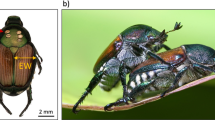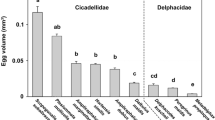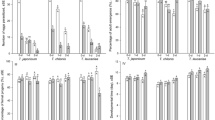Abstract
Trichogramma platneri oviposition behavior on Amorbia cuneana egg masses was investigated under laboratory conditions. No relationship was detected between host surface area, number of edge turning on host eggs, and parasitoid clutch size. It was also observed that females parasitized the egg mass randomly by drilling into the egg mass and parasitizing individual eggs without using stereotypical behaviors to assess individual hosts (i.e. drumming and turning). However, clutch size did change due to ovipositional experience as naïve wasps with little or no ovipositional experience (<6 eggs parasitized), allocated significantly more progeny per host than wasps with longer ovipositional experience (24-h oviposition experience on a single egg mass). Moreover, naïve wasps parasitized significantly more eggs on the outer edge of the egg mass than experienced wasps. We contend that the physical characteristics of A. cuneana eggs and egg masses preclude T. platneri from completely discriminating between individual eggs. However, because T. platneri may be using kairomones from the egg mass, this described oviposition strategy remains effective.

Similar content being viewed by others
References
Bjorksten TA, Hoffmann AA (1998) Separating the effects of experience, size, egg load, and genotype on host response in Trichogramma (Hymenoptera: Trichogrammatidae). J. Insect Behav. 11:129–148
Gardner SM, van Lenteren JC (1986) Characterization of the arrestment responses of Trichogramma evanescens. Oecologia 68:265–270
Heimpel GE, Rosenheim JA (1998) Egg limitation in parasitoids: a review of the evidence and a case study. Biol. Control 11:160–168
Hohmann CL, Luck RF (2004) Effect of host availability and egg load in Trichogramma platneri Nagarkatti (Hymenoptera: Trichogrammatidae) and its consequences on progeny quality. Brazil. Arch. Bio. Tech. 47:413–422
Honda JY, Luck RF (2000) Age and suitability of Amorbia cuneana and Sabulodes aegrotata eggs for Trichogramma platneri. Biol. Control. 18:75–85
Honda JY, Luck RF (2001) Interactions between host attributes and wasp size: a laboratory evaluation of Trichogramma platneri as an augmentative biological control agent for two avocado pests. Entomol. Exp. Appl. 100:1–13
Ikawa T, Suzuki Y (1982) Oviposition experience of gregarious parasitoid, Apanteles glomeratus, influencing her discrimination of host larvae, Pieris rapae crucivora. Appl. Entomol. Zool. 17:119–126
Johnson JJ, Federici BA (1982) Artificial diet and rearing procedures for the omnivorous looper. J. Econ. Entomol. 75:295–296
Klomp H, Teerink BJ (1962) Host selection and number of eggs per oviposition in the egg parasite Trichogramma embryophagum. Nature. 195:1020–1021
Klomp H, Teerink BJ (1967) The significance of oviposition rates in the egg parasite, Trichogramma embryophagum. Arch. Neerl. Zool. 17:350–375
Jones RL, Lewis WJ, Beroza M, Bierl BA, Sparks AN (1973) Host-seeking stimulus (kairomones) for the egg-parasite Trichogramma evanescens. Environ. Entomol. 2:593–596
Le Ralec A, Wajnberg E (1990) Sensory receptors of the ovipositor of Trichogramma maidis (Hym: Trichogrammatidae). Entomophaga. 35:293–299
Luck RF, Podoler H, Kfir R (1982) Host selection and egg allocation behavior by Aphytis melinus and A. lingnanensis : comparison of two facultatively gregarious parasitoids. Ecol. Entomol. 7:397–408
Mansfield S, Mills NJ (2002) Host egg characteristics, physiological host range, and parasitism following inundative release of Trichogramma platneri (Hymenoptera: Trichogrammatidae) in walnut orchards. Envrion. Entomol. 31:723–731
Mills NJ, Kuhlmann U (2000) The relationship between egg load and fecundity among Trichogramma parasitoids. Ecol. Entomol. 25:315–324
Oatman ER, McMurtry JA, Waggonner M, Platner GR, Johnson HG (1983) Parasitization of Amorbia cuneana and Sabulodes aegrotata on avocado in southern California. J. Econ. Entomol. 76:52–53
Pinto JD (1998) Systematics of the North American Species of Trichogramma Westwood (Hymenoptera: Trichogrammatidae). Mem. Entomol. Soc. Wash. 22:1–287
Powell JA, Common IFB (1985) Oviposition patterns and egg characteristics of Australian Tortricine moth. Aust. J. Zool. 33:179–216
Salt G (1937) The sense used by Trichogramma to distinguish between parasitized and unparasitized hosts. P. R. Soc. Ser. B. 122:57–75
Salt G (1935) Experimental studies in insect parasitism III—Host selection. P. R. Soc. Ser. B. 117:413–435
Schmidt JM, Smith JJB (1989) Host examination walk and oviposition site selection of Trichogramma minutum: studies on spherical hosts. J. Insect Behav. 2:143–171
Schmidt JM, Smith JJB (1987a) Measurement of host curvature by the parasitoid wasp Trichogramma minutum, and its effect on host examination and progeny allocation. J. Exp. Biol. 129:151–164
Schmidt JM, Smith JJB (1987b) The measurement of exposed host volume by the parasitoid wasp Trichogramma minutum and the effects of wasp size. Can. J. Zool. 65:2837–2845
Schmidt JM, Smith JJB (1987c) The effect of host spacing on the clutch size and parasitization rate of Trichogramma minutum. Entomol. Exp. Appl. 43:125–131
Schmidt JM, Smith JJB (1985a) The mechanism by which the parasitoid wasp Trichogramma minutum respond to host cluster. Entomol. Exp. Appl. 39:287–294
Schmidt JM, Smith JJB (1985b) Host volume measurement by the parasitoid wasp Trichogramma minutum: the roles of curvature and surface area. Entomol. Exp. Appl. 39:213–221
Suzuki Y, Tsujt H, Sasakawa M (1984) Sex allocation and effects of superparasitism on secondary sex ratio in the gregarious parasitoid, Trichogramma chilonis. Anim. Behav. 32:478–484
SPSS Inc (1999) SPSS Base 10.0 for Windows User’s Guide. SPSS Inc, Chicago
Waage JK, Ng SM (1984) The reproductive strategy of a parasitic wasp I. Optimal progeny and sex allocation in Trichogramma evanescens. J. Anim. Ecol. 53:401–415
Zar JH (1999) Biostatistical Analysis. Prentice Hall, Upper Saddle River
Acknowledgements
We thank Rincon-Vitova Insectaries (Ventura, CA) for providing T. platneri, Max Badgely for providing the A. cuneana egg mass photograph, and Dave Machlitt for providing us with the Amorbia larvae to initiate cultures. We are grateful to Drs. Shannon Bros and Michael Kutilek for their insightful comments. We also thank Berry Smith (University of Toronto) and Josephine Jose for their helpful input, and many thanks to the anonymous reviewers for their valuable comments. Financial support was provided by the Pisano Research Fellowship from the Biological Sciences Department of San Jose State University. This study was performed in partial fulfillment of the Master’s degree to ZN.
Author information
Authors and Affiliations
Corresponding author
Rights and permissions
About this article
Cite this article
Nisani, Z., Honda, J.Y. Does the Polyphagous Egg Parasitoid Trichogramma platneri Nagarkatti (Hymenoptera: Trichogrammatidae) Display Behavioral Plasticity When Parasitizing Different Hosts?. J Insect Behav 23, 81–89 (2010). https://doi.org/10.1007/s10905-009-9197-9
Revised:
Accepted:
Published:
Issue Date:
DOI: https://doi.org/10.1007/s10905-009-9197-9




